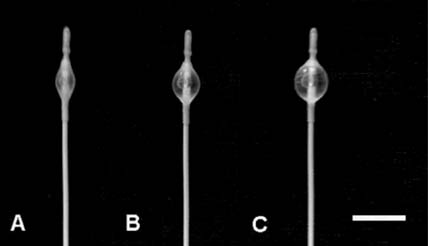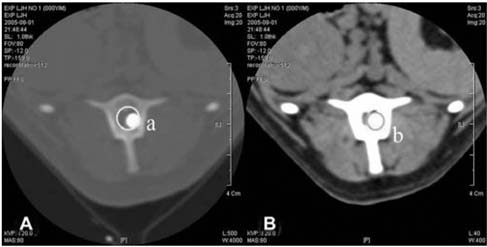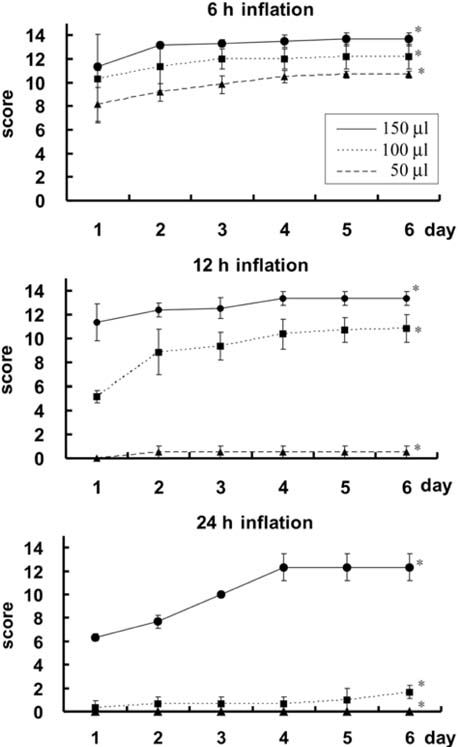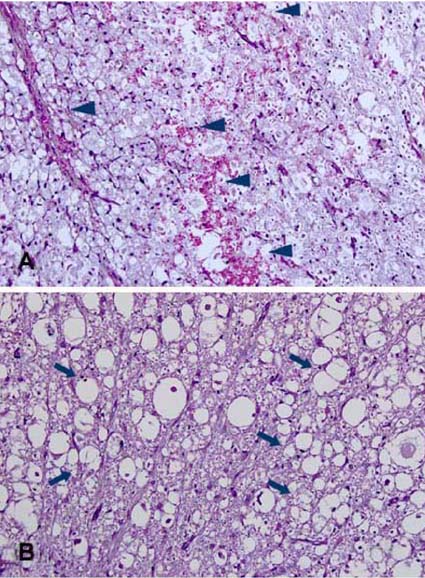J Vet Sci.
2007 Mar;8(1):89-94. 10.4142/jvs.2007.8.1.89.
Establishment of a canine spinal cord injury model induced by epidural balloon compression
- Affiliations
-
- 1Department of Veterinary Surgery, College of Veterinary Medicine, Seoul National University, Seoul 151-742, Korea. ohkweon@snu.ac.kr
- 2Laboratory of Stem Cell and Tumor Biology, Department of Veterinary Public Health, College of Veterinary Medicine, Seoul National University, Seoul 151-742, Korea. kangpub@snu.ac.kr
- 3Department of Veterinary Radiology, College of Veterinary Medicine, Seoul National University, Seoul 151-742, Korea.
- KMID: 1104241
- DOI: http://doi.org/10.4142/jvs.2007.8.1.89
Abstract
- A model that provides reproducible, submaximal yet sufficient spinal cord injury is needed to allow experiments leading to development of therapeutic techniques and prediction of clinical outcome to be conducted. This study describes an experimental model for spinal cord injury that uses three different volumes of balloon inflation and durations of compression to create a controlled gradation outcome in adult dogs. Twenty-seven mongrel dogs were used for this study. A 3-french embolectomy catheter was inserted into the epidural space through a left hemilaminectomy hole at the L4 vertebral arch. Balloons were then inflated with 50, 100, or 150 microliter of a contrast agent at the L1 level for 6, 12, or 24 h and spinal canal occlusion (SCO) measured using computed tomography. Olby score was used to evaluate the extent of spinal cord injury and a histopathologic examination was conducted 1 week after surgery. The SCO of the 50, 100, and 150 microliter inflations was 22-46%, 51-70%, and 75-89%, respectively (p < 0.05). Olby scores were diminished significantly by a combination of the level of SCO and duration of inflation in all groups. Olby scores in the groups of 150 microliter-12 h, 150 microliter-24 h, and 100 microliter-24 h were 0.5, 0, and 1.7, respectively. Based on these results, a SCO > 50% for 24 h, and > 75% for 12 h induces paraplegia up to a week after spinal cord injury.
MeSH Terms
Figure
Cited by 2 articles
-
Improved rat spinal cord injury model using spinal cord compression by percutaneous method
Wook-Hun Chung, Jae-Hoon Lee, Dai-Jung Chung, Wo-Jong Yang, A-Jin Lee, Chi-Bong Choi, Hwa-Seok Chang, Dae-Hyun Kim, Hyo Jin Chung, Hyun Jung Suh, Soo-Han Hwang, Hoon Han, Sun Hee Do, Hwi-Yool Kim
J Vet Sci. 2013;14(3):329-335. doi: 10.4142/jvs.2013.14.3.329.Transplantation of canine umbilical cord blood-derived mesenchymal stem cells in experimentally induced spinal cord injured dogs
Ji-Hey Lim, Ye-Eun Byeon, Hak-Hyun Ryu, Yun-Hyeok Jeong, Young-Won Lee, Wan Hee Kim, Kyung-Sun Kang, Oh-Kyeong Kweon
J Vet Sci. 2007;8(3):275-282. doi: 10.4142/jvs.2007.8.3.275.
Reference
-
1. Carlson GD, Gorden CD, Oliff HS, Pillai JJ, LaManna JC. Sustained spinal cord compression: part I: time-dependent effect on long-term pathophysiology. J Bone Joint Surg Am. 2003. 85-A:86–94.2. Dabney KW, Ehrenshteyn M, Agresta CA, Twiss JL, Stern G, Tice L, Salzman SK. A model of experimental spinal cord trauma based on computer-controlled intervertebral distraction: characterization of graded injury. Spine. 2004. 29:2357–2364.
Article3. Fukuda S, Nakamura T, Kishigami Y, Endo K, Azuma T, Fujikawa T, Tsutsumi S, Shimizu Y. New canine spinal cord injury model free from laminectomy. Brain Res Brain Res Protoc. 2005. 14:171–180.
Article4. Grill RJ. User-defined variables that affect outcome in spinal cord contusion/compression models. Exp Neurol. 2005. 196:1–5.
Article5. Haldipur N, Tan P, Katory M, Singh S. A safe method of retrograde passage of fogarty embolectomy catheter through difficult iliac arteries. Eur J Vasc Endovasc Surg. 2002. 23:559–561.
Article6. Himes BT, Liu Y, Solowska JM, Snyder EY, Fischer I, Tessler A. Transplants of cells genetically modified to express neurotrophin-3 rescue axotomized Clarke's nucleus neurons after spinal cord hemisection in adult rats. J Neurosci Res. 2001. 65:549–564.
Article7. Kuh SU, Cho YE, Yoon DH, Kim KN, Ha Y. Functional recovery after human umbilical cord blood cells transplantation with brain-derived neutrophic factor into the spinal cord injured rat. Acta Neurochir. 2005. 147:985–992.
Article8. Lepore AC, Fischer I. Lineage-restricted neural precursors survive, migrate, and differentiate following transplantation into the injured adult spinal cord. Exp Neurol. 2005. 194:230–242.
Article9. Martin D, Schoenen J, Delree P, Gilson V, Rogister B, Leprince P, Stevenaert A, Moonen G. Experimental acute traumatic injury of the adult rat spinal cord by a subdural inflatable balloon: methodology, behavioral analysis, and histopathology. J Neurosci Res. 1992. 32:539–550.
Article10. Olby N. Current concepts in the management of acute spinal cord injury. J Vet Intern Med. 1999. 13:399–407.
Article11. Olby N, Harris T, Burr J, Munana K, Sharp N, Keene B. Recovery of pelvic limb function in dogs following acute intervertebral disc herniations. J Neurotrauma. 2004. 21:49–59.
Article12. Olby NJ, De Risio L, Munana KR, Wosar MA, Skeen TM, Sharp NJ, Keene BW. Development of a functional scoring system in dogs with acute spinal cord injuries. Am J Vet Res. 2001. 62:1624–1628.
Article13. Purdy PD, White CL 3rd, Baer DL, Frawley WH, Reichard RR, Pride GL Jr, Adams C, Miller S, Hladik CL, Yetkin Z. Percutaneous translumbar spinal cord compression injury in dogs from an angioplasty balloon: MR and histopathologic changes with balloon sizes and compression times. AJNR Am J Neuroradiol. 2004. 25:1435–1442.14. Rucker N, Lumb W, Scott R. Combined pharmacologic and surgical treatments for acute spinal cord trauma. Am J Vet Res. 1981. 42:1138–1142.
Article15. Satake K, Lou J, Lenke LG. Migration of mesenchymal stem cells through cerebrospinal fluid into injured spinal cord tissue. Spine. 2004. 29:1971–1979.
Article16. Scheff SW, Rabchevsky AG, Fugaccia I, Main JA, Lumpp JE Jr. Experimental modeling of spinal cord injury: characterization of a force-defined injury device. J Neurotrauma. 2003. 20:179–193.
Article17. Shores A, Redding RW, Knecht CD. Spinal-evoked potentials in dogs with acute compressive thoracolumbar spinal cord disease. Am J Vet Res. 1987. 48:1525–1530.18. Sykova E, Jendelova P, Urdzikova L, Lesny P, Hejcl A. Bone Marrow Stem Cells and Polymer Hydrogels-Two Strategies for Spinal Cord Injury Repair. Cell Mol Neurobiol. 2006. 26:1113–1129.
Article19. Thelander U, Fagerlund M, Friberg S, Larsson S. Describing the size of lumbar disc herniations using computed tomography. A comparison of different size index calculations and their relation to sciatica. Spine. 1994. 19:1979–1984.
Article20. Vanicky I, Urdzikova L, Saganova K, Cizkova D, Galik J. A simple and reproducible model of spinal cord injury induced by epidural balloon inflation in the rat. J Neurotrauma. 2001. 18:1399–1407.
Article21. von Euler M, Seiger A, Sundstrom E. Clip compression injury in the spinal cord: a correlative study of neurological and morphological alterations. Exp Neurol. 1997. 145:502–510.
Article22. Webb AA, Jeffery ND, Olby NJ, Muir GD. Behavioural analysis of the efficacy of treatments for injuries to the spinal cord in animals. Vet Rec. 2004. 155:225–230.
Article
- Full Text Links
- Actions
-
Cited
- CITED
-
- Close
- Share
- Similar articles
-
- Erratum: Establishment of a canine spinal cord injury model induced by epidural balloon compression
- A Case of Spontaneous Cervical Spinal Epidural Hematoma: Case Report
- Changes of the Electrophysiological Study in Dogs with Acute Spinal Cord Injury
- Successful electrode insertion for spinal cord stimulation after balloon adhesiolysis in a patient with epidural adhesion - A case report -
- Multiple Myeloma and Epidural Spinal Cord Compression : Case Presentation and a Spine Surgeon's Perspective






